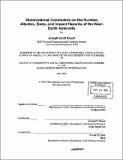Observational constraints on the number, albedos, size, and impact hazards of the near-Earth asteroids
Author(s)
Stuart, Joseph Scott, 1971-
DownloadFull printable version (19.10Mb)
Alternative title
Observational constraints on the number, albedos, size, and impact hazards of the NEAs
Other Contributors
Massachusetts Institute of Technology. Dept. of Earth, Atmospheric, and Planetary Sciences.
Advisor
Richard P. Binzel.
Terms of use
Metadata
Show full item recordAbstract
This work provides a statistical description of the near-Earth asteroids (NEAs) in terms of number, orbital parameters, reflectance spectra, albedos, diameters, and terrestrial and lunar collision rates. I estimate the size and shape of the NEA population using survey data from the Lincoln Near-Earth Asteroid Research project including more than 1300 NEA detections. The NEA population is more highly inclined than previously estimated and the total number of NEAs with absolute magnitudes (H) brighter than 18 is 1227 +170/-90. The absolute magnitude and orbital parameter distributions for the NEAs are combined with reflectance spectra and albedo measurements. I obtain a debiased estimate of the fraction of NEAs in each of 10 taxonomic complexes, and a debiased average albedo for each. The number of NEAs larger than 1 km is 1090 +/- 180. Next, I determine the impact frequency, collision velocity distribution and collision energy distribution for impacts of NEAs into the Earth and Moon. Globally destructive collisions ([approx.] 1021 J) of asteroids 1 km or larger strike the Earth once every 0.60 +/- 0.1 Myr on average. Regionally destructive collisions with impact energy greater than 4x1018 J ([approx.] 200 m diameter) strike the Earth every 47,000 +/- 6,000 years. The rate of formation of craters expected from the NEAs is found to be in close agreement with the observed number of craters on the Earth and Moon. (cont.) These results combine the largest set of NEA discovery statistics from a single survey, the largest set of physical data on NEAs, and corrections for observational bias. The result is a comprehensive estimate of the total NEA population in terms of orbital parameters, absolute magnitudes, albedos, and sizes. This improved description of the NEAs will help us to plan surveys to find and study the remaining undiscovered NEAs, to connect the NEAs to their origins in the main-belt, to connect the NEAs to meteorite samples, to compare the lunar and terrestrial cratering record to the current population of potential impactors, and to understand the magnitude of the NEA impact hazard to the Earth's biosphere.
Description
Thesis (Ph. D.)--Massachusetts Institute of Technology, Dept. of Earth, Atmospheric, and Planetary Sciences, 2003. Includes bibliographical references (p. 132-144).
Date issued
2003Department
Massachusetts Institute of Technology. Department of Earth, Atmospheric, and Planetary SciencesPublisher
Massachusetts Institute of Technology
Keywords
Earth, Atmospheric, and Planetary Sciences.